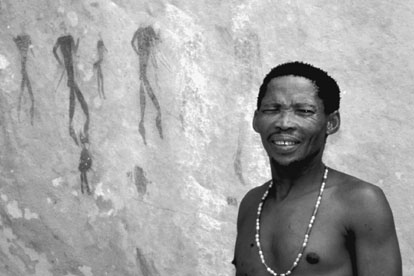

 | Page 1105 |  |
it was ignored at the time. European discoveries in Australia began during the first months of colonization in 1788 and continued sporadically over the next century as explorers and pioneers pushed further into the country. At first, very few sites were discovered or documented, and the colonizers made little effort to inquire about the meaning of motifs and designs. The art was considered to be childish attempts by primitive people to produce paintings and radically inferior to the European art of the period.

A San (bushman) in South Africa standing by an example of ancient rock art
(South African Tourist Board)
The first known European discovery of Australian rock art was made in Bantry Bay, near Sydney, by Governor Arthur Phillip, the commander of the First Fleet and of the first settlement at Port Jackson, in 1788, when he led short expeditions into the surrounding area. The expedition surgeon’s journal describes how, on 16 April 1788, “We saw… some proofs of their ingenuity in various figures cut on the smooth surfaces of some large stones. They consisted chiefly of representations of themselves in different attitudes, of their canoes, of several sorts of fish and animals; and considering the rudeness of the instruments with which the figures must have been executed, they seemed to exhibit tolerably strong likenesses.”
In his first dispatch of 15 May 1788 to Lord Sydney, Phillip wrote: “In Botany Bay, Port Jackson and Broken Bay we frequently saw the figures of men, shields, and fish roughly cut on the rocks; and on the top of a mountain I saw the figure of a man in the attitude they put themselves in when they are going to dance, which was much better done than I had seen before, and the figure of a large lizard was sufficiently well executed to satisfy every one what animal was meant.”
By the end of the eighteenth century, therefore, prehistoric rock art was being noticed and even copied with increasing frequency, though no great accuracy. In the next century, a turning point was to be reached, not only in numbers of discoveries but also in the realization that some of the art was of great antiquity. Just as archaeology became established by the mid-nineteenth century, when the great antiquity of humankind
 |  |